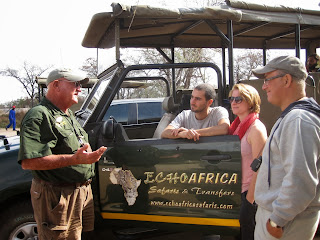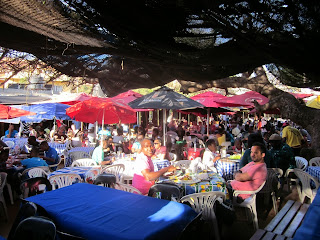 |
Government dignitaries taking a look at the experiments,
I think a mini volcano would have been more impressive |
Ever since I watched Bill Nye back in 3rd grade, I have loved science. But having never gotten the chance to teach science while in Mozambique, the
Science and HIV/AIDS Prevention Fair has been a fantastic opportunity for me to share how I feel about science with Mozambican youth. Moving from a project newbie to provincial fair coordinator to national fair coordinator has been a pretty big change, but this past weekend I took on a new role: oompa loompa. As opposed to last year, where I was running everything as the face, mouth, hands, and wallet of the Zambezia provincial science fair, this year I was only a hand. Since Eric took on the role of Provincial Coordinator, I was free to show up the day before the event, make myself available to help where needed, and to provide reminders, advice, and encouragement (unfortunately, not in a rhyming song while wearing orange face makeup). Though I was sometimes as stressed and crazed as last year, mostly I got to sit back and watch the awesomeness unfold.
 |
Last year's winner, and Alto Molocue resident, Belchoir.
Fierce competition put him in 2nd place this year, but he
still had a great time explaining why cooked potatoes are more
electrically conductive than raw |
This year's Fair was in many ways the same as last year's. After the always present formal opening ceremony by some obscure Mozambican government dignitaries, there was an assortment of cultural performances, and then Fair got under way. The 54 students from 11 districts presented 43 different experiments to judges pulled from local science teachers, the Ministry of Science and Technology, and Peace Corps volunteers. The earnest scientists-in-training demonstrated everything from making mosquito repellent made from locally available ingredients to how to build a sound mixing board from spare parts while the judges, other students, teachers, and community members wandered around taking a look at the experiments and learning from the explanations. To anyone from the US, this would be a very familiar elementary school associated sight, but to most of the participants and observers it is still a novelty, which is why this program exists. Since my role as the National Coordinator involves very little at this level, I resigned myself to take care of registration and collecting scores from the judges. With the rest of my time, I watched the students undergo the exciting and nerve racking experience of explaining the scientific principles behind their experiments to the judges and other questioning participants. Seeing this fantastic demonstration of Mozambican youth with a passion for scientific inquiry makes up for months of teaching a subject I have never loved.
 |
I don't remember what Eric said in his speech, but I know that
the kid sitting next to me said "E verdade, ciencia e assim!"
(That's truth, that is science) in response,
so it must have been good |
At this point, some of you might be asking "What does this have to do with HIV/AIDS prevention? Why does the US Government support this organizationally and financially under the umbrella of HIV/AIDS relief ?" Well, I'm happy to say that this year's Mozmabican Science and HIV/AIDS Prevention Fair is more HIV prevention-y than ever before. First, there are the awareness messages, in the form of copious amounts of red ribbons and the presentation of several HIV themed cultural pieces (a song about the importance of getting tested for HIV and a play demonizing the discrimination of people who are HIV positive). Then there is the free and voluntary testing made available, after a disappointingly large amount of effort and stress, throughout the Fair (thankfully, of the 17 people tested, 17 were negative). Finally, for the time ever, each participant had to answer true or false questions about how HIV is transmitted and prevented as part of their judging process. All this wrapped into a grant application highlighting the importance of extra-curricular activities to reduce the rate of new HIV infections in youth justifies the US tax dollars spent on this event, as if building a base of science and technology oriented citizens in the developing world by getting kids excited in scientific discovery wasn't reason enough.
.jpeg) |
Taking my "supporting in the background" role to heart, the
back of my head made an appearance in the winner's
photo while I was fixing a prematurely removed banner |
Once the 6 hours of judging was over, Eric announced the special awards (project most relevant to the community, project most related to HIV/AIDS, and best female project) and 3rd, 2nd, and 1st winners while handing them their fancy certificates and prizes. After a flurry of photos and certificate name corrections, the Fair came to an end and all the participants began to leave. Since the two first place winners (8-10th grade and 11-12th grade) from Murrumbala and Milange will be representing Zambezia at the National Fair (also in Quelimane on September 14th) we held a little logistical and strategy session with them and their teachers, and then went back to the hotel to change and shower for the nights festivities.
As opposed to organizing last year's Fair as a lone newbie and the resulting stress, this year's Fair was far more enjoyable. Supporting a new volunteer go through the often complicated process of working with government counterparts (Joao, Humberto and George are awesome!) to plan an event of this scale was simultaneously nostalgic and an satisfying. All I can hope is that the much larger and higher profile National Fair goes just as smoothly. Now if you excuse me, I have a handsome bow-tied nerd genius to channel.


.jpeg)
.jpeg)






.jpeg)

.jpeg)



.jpeg)
.jpeg)

.jpeg)
.jpeg)
.jpeg)






























.jpeg)

.jpeg)
.jpeg)
.jpeg)


.jpeg)
